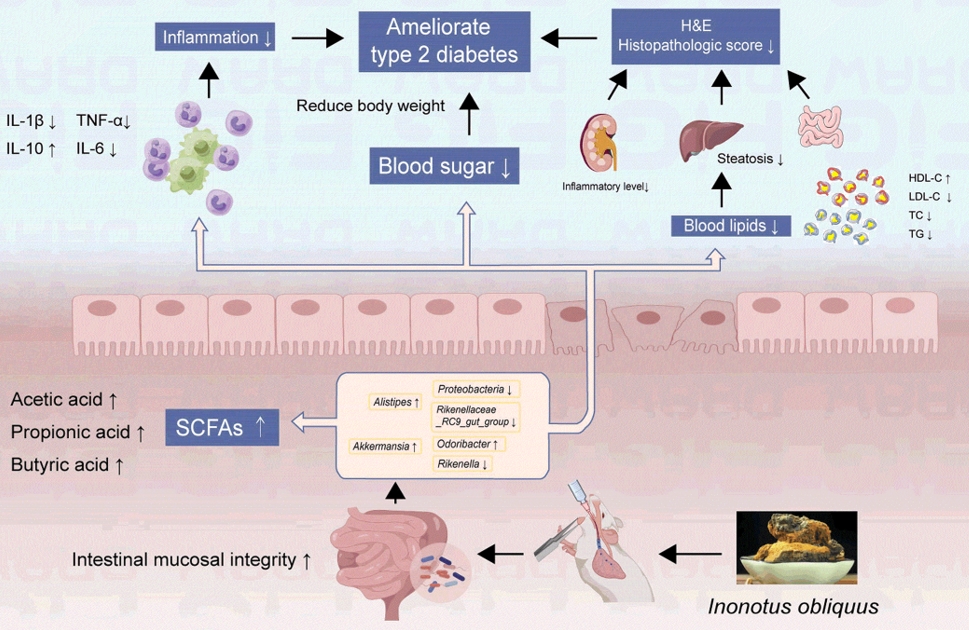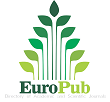Research on Chaga hypoglycemic functional foods
DOI:
https://doi.org/10.18686/fnc.v2i3.231Keywords:
Chaga; blood sugar; functional food; diabetesAbstract
Chaga, also known as Inonotus obliquus (Fr.) Pilát, belongs to the genera Basidiomycotina, Hymenomycetes, Hymenochaetales, Hymenochaetaceae, and Inonotus. Chaga is a brown polypore fungus that mostly grows under the bark of white birch and silver birch trees. It forms sarcoma-like sclerotia when the bark is damaged. It mainly grows in Northern Europe at the 40° to 50° north latitude, Siberia and the Far East in Russia, Hokkaido in Japan, and the Changbai Mountain area of the Heilongjiang Province and Jilin Province in China. Chaga has various pharmacological activities, such as anti-tumor, hypoglycemic, anti-viral, and anti-inflammatory. Inonotus obliquus, an edible fungus with the same origin as medicine and food, has attracted more and more attention. At present, Chaga has become a raw material with great potential for developing functional foods. In this article, Chaga’s blood sugar-lowering function, functional ingredients, and blood sugar-lowering mechanism and the development status of Chaga functional foods are reviewed and Chaga’s future development is analyzed and forecast.

Downloads
Published
How to Cite
Issue
Section
License
Copyright (c) 2024 Sheng Xu, Rui Su, Shuai-shuai Wei, Li-ping Zhang, Wen-han Zhang, Hai-hui Sun, Yan Shen, Wei Ma

This work is licensed under a Creative Commons Attribution 4.0 International License.
References
1. Rhee SJ, Cho SY, Kim KM, et al. A comparative study of analytical methods for alkali-soluble β-glucan in medicinal mushroom, Chaga (Inonotus obliquus). LWT - Food Science and Technology. 2008; 41(3): 545-549. doi: 10.1016/j.lwt.2007.03.028 DOI: https://doi.org/10.1016/j.lwt.2007.03.028
2. Fordjour E, Manful CF, Javed R, et al. Chaga mushroom: A super-fungus with countless facets and untapped potential. Frontiers in Pharmacology. 2023; 14. doi: 10.3389/fphar.2023.1273786 DOI: https://doi.org/10.3389/fphar.2023.1273786
3. Li S. Research progress on chemical components and pharmacological effects of Chaga (Chinese). Doctor. 2017; 2(05): 66, 88. doi: 10.19604/j.cnki.dys.2017.05.039
4. Liu Y, Song G, Guo M, et al. Research progress of active ingredients and pharmacological activity of Chaga mushroom (Chinese). Guiding Journal of Traditional Chinese Medicine and Pharmacy. 2023; 29(01): 96-104. doi: 10.13862/j.cn43-1446/r.2023.01.018
5. W. Thomas P, Ahmed Elkhateeb W, Daba GM. Chaga (Inonotus obliquus): A medical marvel but a conservation dilemma? Sydowia—An International Journal of Mycology. 2020; (72): 123-130. doi: 10.12905/0380.sydowia72-2020-0123
6. Zhang X, Zhang Y. Application status of active ingredients and bioactivities of Betula (Chinese). Journal of Plateau Agriculture. 2018; 2(5): 549-557. doi: CNKI:SUN:GYNY.0.2018-05-015 DOI: https://doi.org/10.1016/j.eneco.2018.10.036
7. Lindequist U, Niedermeyer THJ, Jülich WD. The pharmacological potential of mushrooms. Evidence-Based Complementary and Alternative Medicine. 2000; 2(3): 285-299. doi: 10.1093/ecam/neh107 DOI: https://doi.org/10.1093/ecam/neh107
8. Abu-Reidah IM, Critch AL, Manful CF, et al. Effects of pH and temperature on water under pressurized conditions in the extraction of nutraceuticals from Chaga (Inonotus obliquus) mushroom. Antioxidants. 2021; 10(8): 1322. doi: 10.3390/antiox10081322 DOI: https://doi.org/10.3390/antiox10081322
9. Géry A, Dubreule C, André V, et al. Chaga (Inonotus obliquus), a future potential medicinal fungus in oncology? A chemical study and a comparison of the cytotoxicity against human lung adenocarcinoma cells (A549) and human bronchial epithelial cells (BEAS-2B). Integrative Cancer Therapies. 2018; 17(3): 832-843. doi: 10.1177/1534735418757912 DOI: https://doi.org/10.1177/1534735418757912
10. Wang J, Wang C, Li S, et al. Anti-diabetic effects of Inonotus obliquus polysaccharides in streptozotocin-induced type 2 diabetic mice and potential mechanism via PI3K-Akt signal pathway. Biomedicine & Pharmacotherapy. 2017; 95: 1669-1677. doi: 10.1016/j.biopha.2017.09.104 DOI: https://doi.org/10.1016/j.biopha.2017.09.104
11. Zhu M, Miao L, Li X, Wang L. Preparation of compound Inonotus obliquus tablets and its hypoglycemic effect on diabetic mice (Chinese). Special Wild Economic Animal and Plant Research. 2022; 44(6): 44-49. doi: 10.16720/j.cnki.tcyj.2022.181
12. Zhou X, Zhao J, Wang M, et al. Experimental study on hypoglycemic effect of polysaccharide from medicinal fungus Inonotus obliquus (Chinese). Shanxi Medical Journal. 2019; 48(10): 1163-1166. doi: CNKI:SUN:SXYY.0.2019-10-009
13. Zhao J, Zhu C, Liu L, et al. Study on hypoglycemic effect of polysaccharides from Inonotus obliquus on mice (Chinese). Biological Chemical Engineering. 2021; 7(4): 99-102.
14. Xu X, Pang C, Yang C, et al. Antihyperglycemic and antilipidperoxidative effects of polysaccharides extracted from medicinal mushroom Chaga, Inonotus obliquus (Pers.: Fr.) Pilát (Aphyllophoromycetideae) on alloxan-diabetes mice. International Journal of Medicinal Mushrooms. 2010; 12(3): 235-244. doi: 10.1615/intjmedmushr.v12.i3.20 DOI: https://doi.org/10.1615/IntJMedMushr.v12.i3.20
15. Lu X, Chen H, Dong P, et al. Phytochemical characteristics and hypoglycaemic activity of fraction from mushroom Inonotus obliquus. Journal of the Science of Food and Agriculture. 2009; 90(2): 276-280. doi: 10.1002/jsfa.3809 DOI: https://doi.org/10.1002/jsfa.3809
16. Liu C, Cui J, Wang S, et al. Protective effect of Inonotus obliquus polysaccharides on kidneys of diabetic kidney disease mice (Chinese). Science and Technology of Food Industry. 2021; 42(2): 321-325. doi: 10.13386/j.issn1002-0306.2020050108
17. Feng Y, Liu J, Gong L, et al. Inonotus obliquus (Chaga) against HFD/STZ-induced glucolipid metabolism disorders and abnormal renal functions by regulating NOS-cGMP-PDE5 signaling pathway. Chinese Journal of Natural Medicines, 2024, 22(7): 619–631. doi: 10.1016/S1875-5364(24)60616-3 DOI: https://doi.org/10.1016/S1875-5364(24)60616-3
18. Wang C. Study on the basis of hypoglycemic active substances in Inonotus obliquus (Chinese) [PhD thesis]. Tianjin University; 2018. doi: 10.27356/d.cnki.gtjdu.2018.002924
19. Zhu F, Du B, Bian Z, et al. Beta-glucans from edible and medicinal mushrooms: Characteristics, physicochemical and biological activities. Journal of Food Composition and Analysis. 2015; 41: 165-173. doi: 10.1016/j.jfca.2015.01.019 DOI: https://doi.org/10.1016/j.jfca.2015.01.019
20. Luan F, Ji Y, Peng L, et al. Extraction, purification, structural characteristics and biological properties of the polysaccharides from Codonopsis pilosula: A review. Carbohydrate Polymers. 2021; 261: 117863. doi: 10.1016/j.carbpol.2021.117863 DOI: https://doi.org/10.1016/j.carbpol.2021.117863
21. Virgen-Carrillo CA, Martínez Moreno AG, Valdés Miramontes EH. Potential hypoglycemic effect of pomegranate juice and its mechanism of action: A systematic review. Journal of Medicinal Food. 2020; 23(1): 1-11. doi: 10.1089/jmf.2019.0069 DOI: https://doi.org/10.1089/jmf.2019.0069
22. Guo M, Shao S, Wang D, et al. Recent progress in polysaccharides from Panax ginseng C. A. Meyer. Food & Function. 2021; 12(2): 494-518. doi: 10.1039/d0fo01896a DOI: https://doi.org/10.1039/D0FO01896A
23. He P, Zhang Y, Li N. The phytochemistry and pharmacology of medicinal fungi of the genus Phellinus: A review. Food & Function. 2021; 12(5): 1856-1881. doi: 10.1039/d0fo02342f DOI: https://doi.org/10.1039/D0FO02342F
24. Shen J, Hu M, Tan W, et al. Traditional uses, phytochemistry, pharmacology, and toxicology of Coreopsis tinctoria Nutt.: A review. Journal of Ethnopharmacology. 2021; 269: 113690. doi: 10.1016/j.jep.2020.113690 DOI: https://doi.org/10.1016/j.jep.2020.113690
25. Xia Q. Evaluation of the hypoglycemic effect of Inonotus obliquus in vivo and in vitro and identification of its active ingredients (Chinese) [Master’s thesis]. Huazhong Agricultural University; 2020. doi: 10.27158/d.cnki.ghznu.2020.001254
26. Shao Z, Zhang Y, Wan G, et al. Study on the hypoglycemic activity of complex polysaccharides based on Inonotus obliquus (Chinese). Guangdong Chemical Industry. 2017; 44(16): 14-15. doi: CNKI:SUN:GDHG.0.2017-16-007
27. Ye X, Wu K, Xu L, et al. Methanol extract of Inonotus obliquus improves type 2 diabetes mellitus through modifying intestinal flora. Frontiers in Endocrinology. 2023; 13. doi: 10.3389/fendo.2022.1103972 DOI: https://doi.org/10.3389/fendo.2022.1103972
28. Wang S, Wang R, Li R, et al. Research progress on application of Inonotus obliquus in diabetic kidney disease. Journal of Inflammation Research. 2023; 16: 6349-6359. doi: 10.2147/jir.s431913 DOI: https://doi.org/10.2147/JIR.S431913
29. Zhang Y, Liao H, Shen D, et al. Renal protective effects of Inonotus obliquus on high-fat diet/streptozotocin-induced diabetic kidney disease rats: Biochemical, color Doppler ultrasound and histopathological evidence. Frontiers in Pharmacology. 2022; 12. doi: 10.3389/fphar.2021.743931 DOI: https://doi.org/10.3389/fphar.2021.743931
30. Chou YJ, Kan WC, Chang CM, et al. Renal protective effects of low molecular weight of Inonotus obliquus polysaccharide (LIOP) on HFD/STZ-induced nephropathy in mice. International Journal of Molecular Sciences. 2016; 17(9): 1535. doi: 10.3390/ijms17091535 DOI: https://doi.org/10.3390/ijms17091535
31. Wang C, Gao X, Santhanam RK, et al. Effects of polysaccharides from Inonotus obliquus and its chromium (III) complex on advanced glycation end-products formation, α-amylase, α-glucosidase activity and H2O2-induced oxidative damage in hepatic L02 cells. Food and Chemical Toxicology. 2018; 116: 335-345. doi: 10.1016/j.fct.2018.04.047 DOI: https://doi.org/10.1016/j.fct.2018.04.047
32. Wang C, Chen Z, Pan Y, et al. Anti-diabetic effects of Inonotus obliquus polysaccharides-chromium (III) complex in type 2 diabetic mice and its sub-acute toxicity evaluation in normal mice. Food and Chemical Toxicology. 2017; 108: 498-509. doi: 10.1016/j.fct.2017.01.007 DOI: https://doi.org/10.1016/j.fct.2017.01.007
33. Sun J, Xu H, Ao Z, et al. Study on the hypoglycemic effect of Inonotus obliquus and Tricholoma matsutake powder (Chinese). Natural Product Research and Development. 2009; 21(2): 339-342. doi: 10.16333/j.1001-6880.2009.02.040
34. Liu P, Xue J, Tong S, et al. Structure characterization and hypoglycaemic activities of two polysaccharides from Inonotus obliquus. Molecules. 2018; 23(8): 1948. doi: 10.3390/molecules23081948 DOI: https://doi.org/10.3390/molecules23081948
35. Das AK, Nanda PK, Dandapat P, et al. Edible mushrooms as functional ingredients for development of healthier and more sustainable muscle foods: A flexitarian approach. Molecules. 2021; 26(9): 2463. doi: 10.3390/molecules26092463 DOI: https://doi.org/10.3390/molecules26092463
36. Sharpe E, Farragher-Gnadt AP, Igbanugo M, et al. Comparison of antioxidant activity and extraction techniques for commercially and laboratory prepared extracts from six mushroom species. Journal of Agriculture and Food Research. 2021; 4: 100130. doi: 10.1016/j.jafr.2021.100130 DOI: https://doi.org/10.1016/j.jafr.2021.100130
37. Pei H, Zhang M, Qin Y, et al. Research progress on pharmacological effects of polyphenols (Chinese). China Pharmaceuticals. 2022; 31(23): 124-127. doi: 10.3969/j.issn.1006 -4931.2022.23.030
38. Dong Q, Gao S, Cao L. Purification of polyphenols from Inonotus obliquus by macroporous resin and analysis of its components (Chinese). Food Science. 2015; 36(22): 131-136. doi: 10.7506/spkx1002-6630-201522024
39. Zhu J, Xu X. Liquid deep preparation and antioxidant activity of Inonotus obliquus polyphenols (Chinese). Journal of Zhejiang Sci-Tech University. 2011; 28(4): 616-620. doi: 10.3969/j.issn.1673-3851.2011.04.028
40. Nakajima Y, Sato Y, Konishi T. Antioxidant small phenolic ingredients in Inonotus obliquus (persoon) Pilat (Chaga). Chemical and Pharmaceutical Bulletin. 2007; 55(8): 1222-1226. doi: 10.1248/cpb.55.1222 DOI: https://doi.org/10.1248/cpb.55.1222
41. Peng H, Shahidi F. Qualitative analysis of secondary metabolites of chaga mushroom (Inonotus obliquus): Phenolics, fatty acids, and terpenoids. Journal of Food Bioactives. 2022; 17: 56–72. doi: 10.31665/jfb.2022.17304 DOI: https://doi.org/10.31665/JFB.2022.17304
42. Iwai K. Antidiabetic and antioxidant effects of polyphenols in brown alga Ecklonia stolonifera in genetically diabetic KK-Ay mice. Plant Foods for Human Nutrition. 2008; 63(4): 163-169. doi: 10.1007/s11130-008-0098-4 DOI: https://doi.org/10.1007/s11130-008-0098-4
43. Tadera K, Minami Y, Takamatsu K, et al. Inhibition of α-glucosidase and α-amylase by flavonoids. Journal of Nutritional Science and Vitaminology. 2006; 52(2): 149-153. doi: 10.3177/jnsv.52.149 DOI: https://doi.org/10.3177/jnsv.52.149
44. Prabhakar PK, Doble M. Synergistic effect of phytochemicals in combination with hypoglycemic drugs on glucose uptake in myotubes. Phytomedicine. 2009; 16(12): 1119-1126. doi: 10.1016/j.phymed.2009.05.021 DOI: https://doi.org/10.1016/j.phymed.2009.05.021
45. Wu J, Li W, Qu Z, et al. Action mechanism of Inonotus obliquus in the treatment of diabetes and the material basis of pharmacodynamics based on network pharmacology (Chinese). Science and Technology of Food Industry. 2021; 42(22): 18-29. doi: 10.13386/j.issn1002-0306.2021040268
46. Liu Y, Song G, Guo M, et al. Research progress of active ingredients and pharmacological activity of Chaga mushroom (Chinese). Guiding Journal of Traditional Chinese Medicine and Pharmacology. 2023; 29(1): 96-104. doi: 10.13862/j.cn43-1446/r.2023.01.018
47. Huang P, Chen C, Xu X. Inhibitory activity of triterpenoids from Inonotus obliquus on α-glucosidase and α-amylase and identification of their effective compounds (Chinese). Journal of Zhejiang Sci-Tech University. 2020; 43(5): 678-686. doi: 10.3969/j.issn.1673-3851(n).2020.05.013
48. Wang S, Wang R, Li R, et al. Research progress on application of Inonotus obliquus in diabetic kidney disease. Journal of Inflammation Research. 2023; Volume 16: 6349-6359. doi: 10.2147/jir.s431913 DOI: https://doi.org/10.2147/JIR.S431913
49. Singla RK, Singh R, Dubey AK. Important aspects of post-prandial antidiabetic drug, acarbose. Current Topics in Medicinal Chemistry. 2016; 16(23): 2625-2633. doi: 10.2174/1568026616666160414123500 DOI: https://doi.org/10.2174/1568026616666160414123500
50. Yang J, Meng L. Research progress on Inonotus obliquus and its pharmacological effects (Chinese). Edible and Medicinal Mushrooms. 2021; 29(3): 202-207. doi: 2095-0934(2021)03-202-06
51. Du W, Wang Q. A review of the distribution and pharmacological activity of Inonotus obliquus (Chinese). Journal of Fungal Research. 2013; 11(1): 49-56. doi: 10.13341/j.jfr.2013.01.008
52. Li Y, Guo S, Xu L, et al. Study on review of the distribution and environmental conditions of Inonotus obliquus (Chinese). Forest By-Product and Speciality in China. 2019; 4: 60-65. doi: 10.13268/j.cnki.fbsic.2019.04.024
53. Sułkowska-Ziaja K, Robak J, Szczepkowski A, et al. Comparison of bioactive secondary metabolites and cytotoxicity of extracts from Inonotus obliquus isolates from different host species. Molecules. 2023; 28(13): 4907. doi: 10.3390/molecules28134907 DOI: https://doi.org/10.3390/molecules28134907
54. Zheng W, Zhang M, Zhao Y, et al. Accumulation of antioxidant phenolic constituents in submerged cultures of Inonotus obliquus. Bioresource Technology. 2009; 100(3): 1327-1335. doi: 10.1016/j.biortech.2008.05.002 DOI: https://doi.org/10.1016/j.biortech.2008.05.002
55. Xue J, Tong S, Wang Z, et al. Chemical Characterization and hypoglycaemic activities in vitro of two polysaccharides from Inonotus obliquus by submerged culture. Molecules. 2018; 23(12): 3261. doi: 10.3390/molecules23123261 DOI: https://doi.org/10.3390/molecules23123261
56. Jarosz A, Skórska M, Rzymowska J, et al. Effect of the extracts from fungus Inonotus obliquus on catalase level in HeLa and nocardia cells. Acta Biochimica Polonica. 1990; 37(1): 149-151. doi: 10.1016/0005-2728(90)90227-U DOI: https://doi.org/10.1016/0005-2728(90)90227-U
57. Jiang Z. Study on liquid fermentation culture of Inonotus obliquus and its bioactive substances (Chinese) [Master’s thesis]. Dalian Polytechnic University; 2016. doi: CNKI:CDMD:2.1016.285339
58. Xu X, Li J, Hu Y. Polysaccharides from Inonotus obliquus sclerotia and cultured mycelia stimulate cytokine production of human peripheral blood mononuclear cells in vitro and their chemical characterization. International Immunopharmacology. 2014; 21(2): 269-278. doi: 10.1016/j.intimp.2014.05.015 DOI: https://doi.org/10.1016/j.intimp.2014.05.015
59. Yan S, Guo S. Optimization of fermentation conditions of Inonotus obliquus and research on hypoglycemic in vitro (Chinese). Journal of Anhui Agricultural Sciences. 2021; 49(19): 157-160. doi: 10.3969/j.issn.0517-6611.2021.19.041
60. Chen S, Tian Y, Ma J, et al. Current status and prospects of research on polysaccharides from Inonotus obliquus (Chinese). Food Research & Development. 2022; 43(22): 215-224. doi: 10.12161/j.issn.1005-6521.2022.22.030
61. Lou H, Li H, Wei T, et al. Stimulatory effects of oleci acid and fungal elicitor on betulinic acid production by submerged cultivation of medicinal mushroom inonotus obliquus. Journal of Fungi. 2021; 7(4): 266. doi: 10.3390/jof7040266 DOI: https://doi.org/10.3390/jof7040266
62. Xu X, Hu Y, Quan L. Production of bioactive polysaccharides by Inonotus obliquus under submerged fermentation supplemented with lignocellulosic biomass and their antioxidant activity. Bioprocess and Biosystems Engineering. 2014; 37(12): 2483-2492. doi: 10.1007/s00449-014-1226-1 DOI: https://doi.org/10.1007/s00449-014-1226-1
63. Abu-Reidah IM, Critch AL, Manful CF, et al. Effects of pH and temperature on water under pressurized conditions in the extraction of nutraceuticals from Chaga (Inonotus obliquus) mushroom. Antioxidants. 2021; 10(8): 1322. doi: 10.3390/antiox10081322 DOI: https://doi.org/10.3390/antiox10081322
64. Huynh N, Beltrame G, Tarvainen M, et al. Supercritical CO2 extraction of triterpenoids from Chaga sterile conk of Inonotus obliquus. Molecules. 2022; 27(6): 1880. doi: 10.3390/molecules27061880 DOI: https://doi.org/10.3390/molecules27061880
65. Chen Z, Zhou X, Hua R, et al. Research status and application prospects of Inonotus obliquus (Chinese). Edible Fungi of China. 2021; 40(10): 1-6. doi: 10.13629/j.cnki.53-1054.2021.10.001
66. Lu Y, Jia Y, Xue Z, et al. Recent Developments in Inonotus obliquus (Chaga mushroom) polysaccharides: Isolation, structural characteristics, biological activities and application. Polymers. 2021; 13(9): 1441. doi: 10.3390/polym13091441 DOI: https://doi.org/10.3390/polym13091441
67. Shashkina MYa, Shashkin PN, Sergeev AV. Chemical and medicobiological properties of Chaga (review). Pharmaceutical Chemistry Journal. 2006; 40(10): 560-568. doi: 10.1007/s11094-006-0194-4 DOI: https://doi.org/10.1007/s11094-006-0194-4
68. Wang L, Sun T, Zhen X, et al. Study on Inonotus obliquus lactic acid bacteria beverage (Chinese). Food Science and Technology. 2009; 34(9): 101-103. doi: CNKI:SUN:SSPJ.0.2009-09-030
69. Chen H, Liou B, Hsu K, et al. Implementation of food safety management systems that meets ISO 22000: 2018 and HACCP: A case study of capsule biotechnology products of chaga mushroom. Journal of Food Science. 2020; 86(1): 40-54. doi: 10.1111/1750-3841.15553 DOI: https://doi.org/10.1111/1750-3841.15553
70. Alkhatib A, Klonizakis M. Effects of exercise training and Mediterranean diet on vascular risk reduction in post-menopausal women. Clinical Hemorheology and Microcirculation. 2014; 57(1): 33-47. doi: 10.3233/ch-131770 DOI: https://doi.org/10.3233/CH-131770
71. Middleton G, Keegan R, Smith MF, et al. Implementing a Mediterranean diet intervention into a RCT: Lessons learned from a non-Mediterranean based country. The Journal of Nutrition, Health & Aging. 2015; 19(10): 1019-1022. doi: 10.1007/s12603-015-0663-0 DOI: https://doi.org/10.1007/s12603-015-0663-0
72. Martínez-González MA. Benefits of the Mediterranean diet beyond the Mediterranean Sea and beyond food patterns. BMC Medicine. 2016; 14(1). doi: 10.1186/s12916-016-0714-3 DOI: https://doi.org/10.1186/s12916-016-0714-3
73. Topolska K, Florkiewicz A, Filipiak-Florkiewicz A. Functional food—Consumer motivations and expectations. International Journal of Environmental Research and Public Health. 2021; 18(10): 5327. doi: 10.3390/ijerph18105327 DOI: https://doi.org/10.3390/ijerph18105327




.jpg)
.jpg)

